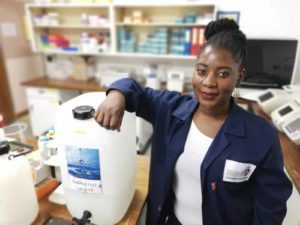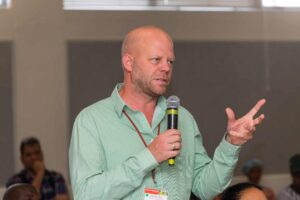In a new book chapter and at a recent webinar, scholars within the DSI-NRF Centre of Excellence in Food Security (CoE-FS) have hailed South Africa’s National School Nutrition Programme (NSNP). But in addition to safety and quality concerns, the programme has also not capitalised on its potential to bring about change in the country’s broader food system, they argue.

Each school day, the National School Nutrition Programme provides at least one meal to over nine million school learners across 20 000 schools around the country. RODNAE Productions / Pexels.
Obakeng Sepeng is a teacher in Pretoria, and has nothing but praise for South Africa’s NSNP. Addressing a webinar on ‘School Food, Equity and Social Justice’, Sepeng spoke fondly of how the programme has improved his learners’ concentration, gets his learners to school on time (for the breakfast meal), and has reduced learner absenteeism. What’s more, he pointed out, he benefitted from the programme when he was a primary and high school learner.
“It is a developing programme but it is on the right track, based on my experience,” said Sepeng, who is also a master’s student in Development Studies at the University of Pretoria (UP), co-host of the CoE-FS.
There’s good reason for that acclaim. Each school day, the programme provides at least one meal to over nine million school learners across 20 000 schools around the country. For many, the school meal is possibly the most substantial of their day.
This suggests that the NSNP is achieving many of its lofty goals. Among other things, the programme aims to improve learners’ concentration and keep them in school; reduce childhood stunting, which currently stands at around 27%; and in so doing, is helping the country make inroads into its racial, financial and social inequalities.
But the programme is not without its missteps and shortcomings, note the three UP authors of a chapter on the NSNP that appears in the newly released Routledge book School Food, Equity and Social Justice: Critical Reflections and Perspectives. The book, as a whole, looks at school feeding programmes and concerns in countries in Africa, Latin America, Asia and Europe.
In their chapter, “School Food and the Promotion of a More Just and Equitable Food System in South Africa”, Dr Marc Wegerif, Thabang Msimango and Dr Nokuthula Vilakazi point to specific concerns around food safety and its untapped potential to transform the South African food system.
Safety, budget and local ingredients
Speaking at the webinar, Msimango, now a doctoral candidate at UP, spoke of the findings from her master’s thesis (for which she received CoE-FS funding), where she looked at food safety at 12 NSNP schools in Gauteng and Mpumalanga. Over the past years, she explained, several cases of food poisoning have been reported at schools around the country.

Thabang Msimango.
In the samples of fresh produce she collected for her study, she also identified several foodborne pathogens. Msimango also found that the voluntary food handlers, while having some knowledge of food safety and hygiene, did not always practice what they knew. In addition, many schools lacked the infrastructure to refrigerate, store and prepare food safely.
“Food safety in schools is very important because if you are giving food-insecure people food that is not safe to eat, they may get sick, and that defeats the whole purpose,” she said.
Another concern is that the NSNP’s budget, while certainly substantial – it took up some R7.5 billion of the Department of Basic Education’s (DBE) coffers in 2020 – is just not enough, said Dr Wegerif, a CoE-FS project lead.
That the programme is efficient can’t be debated, he insists. According to a 2016 implementation evaluation conducted for the DBE, a cooked meal was produced for less than R3.00 per learner (or more recently, R4.30 per meal). But this amount hardly makes for lavish banquets. While schools were expected to complement the budget with food gardens, meals are lean and are particularly light on fresh vegetables, raw fruit and nutritional variety.
Part of the problem, said Dr Vilakazi, is that the programme doesn’t make the best use of affordable local ingredients and indigenous produce.
“We need to diversify the meals,” she noted. “We need to find value in our own [produce].”
Tackling inequalities
More worrying, the sizeable price tag of the NSNP has not been leveraged enough to tackle the inequalities in the food system as a whole; not enough of the budget is fed into local communities and economies, argued Wegerif.
The NSNP runs along two procurement models, he explained: a decentralised model where schools procure foodstuffs themselves; and a centralised model where provincial education departments issue tenders and appoint service providers to supply schools on contract.
In spirit, if not black-and-white policy, both models are meant to be informed by a homegrown school feeding (HGSF) approach that seeks to stimulate local agricultural and economic development. This would include buying from small-scale black farmers, in so doing giving them a boost by injecting steady income into their businesses. But that is not how procurement often pans out, pointed out Wegerif.

Dr Marc Wegerif.
Regardless of which model provinces apply, and despite sticking to broad-based black economic empowerment tendering processes, schools and contracted suppliers – citing reliability issues – invariably end up buying their goods from large, often white-owned, suppliers. These suppliers in turn buy from large food processing companies and commercial farms.
One remedy would be to coordinate agricultural supply-side support with the demand created by the NSNP, suggest the authors. In this way, the capacity of black farmers can be developed to meet the needs of the programme.
“The programme is impressive, and it works,” said Wegerif.
“But it could drive bigger change in our highly unequal agri-food system.”
Integrated approach
Further questions still hang over the programme. No comprehensive evaluation has as yet been conducted on its outcomes to determine whether, for example, it has improved drop-out rates or not. Although numbers are hotly debated, a 2020 report suggests that in South Africa, as many as half of the learners who start Grade 1 leave school before they get to matric.
Limited-in-scale studies have, however, found possible associations between the NSNP and both improved marks and a reduction in stunting.
But to address these big issues of stunting, throughput and inequality, the NSNP cannot be seen as a standalone instrument, said Associate Professor Dorte Ruge of the University College Lillebaelt, Denmark, one of the editors of the Routledge book.
Her work is around adopting an integrated approach, she explained.
“[This] means that you need to do several things at the same time,” Associate Professor Ruge said. “But in northern Europe, we tend to say, we’ll just take the healthy foods and put it in schools and then we leave and we won’t do anything else. And it doesn’t work.”
It’s a lesson South Africa should take to heart.
The 16 March webinar forms part of the #FoodTalks webinar series, a collaboration between the DSI-NRF Centre of Excellence in Food Security, UP, and the Food Systems Research Networks for Africa (FSNet-Africa).
related Articles
CoE-FS co-director Lise Korsten awarded prestigious hon doc from Ghent University
New study assesses compliance with South Africa’s proposed R3337 regulations
Photo RF._.studio / Pexels. In light of the South African government’s publication of a draft regulation to introduce warning labels…
Five tips to better food safety in the kitchen
Here are five tips to better food safety in the kitchen: Always wash counters, knives and containers. Photo Kaboompics.com/Pexels. 2….



